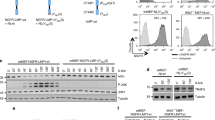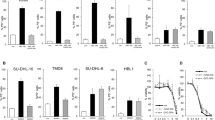Abstract
Bcr-Abl tyrosine kinase, a chimeric oncoprotein responsible for chronic myelogenous leukemia, constitutively activates several signal transduction pathways that stimulate cell proliferation and prevent apoptosis in hematopoietic cells. The antiapoptotic function of Bcr-Abl is necessary for hematopoietic transformation, and also contributes to leukemogenesis. Herein, we show for the first time that cell transformation induced by Bcr-Abl leads to increased expression and kinase activity of MEK kinase 1 (MEKK1), which acts upstream of the c-Jun N-terminal kinase (JNK), extracellular signal regulated kinase (ERK) and NF-κB signaling pathways. Inhibition of MEKK1 activity using a dominant-negative MEKK1 mutant (MEKK1km) diminished the ability of Bcr-Abl to protect cells from genotoxin-induced apoptosis, but had no effect on the proliferation of Bcr-Abl-transformed cells. Expression of MEKK1km also reduced NF-κB activation, and inhibited antiapoptotic c-IAP1 and c-IAP2 mRNA expression in response to the genotoxin. By contrast, neither JNK nor ERK activation was affected. These results indicate that MEKK1 is a downstream target of Bcr-Abl, and that the antiapoptotic effect of Bcr-Abl in chronic myelogenous leukemia cells is mediated via the MEKK1-NF-κB pathway.
This is a preview of subscription content, access via your institution
Access options
Subscribe to this journal
Receive 50 print issues and online access
$259.00 per year
only $5.18 per issue
Buy this article
- Purchase on Springer Link
- Instant access to full article PDF
Prices may be subject to local taxes which are calculated during checkout







Similar content being viewed by others
References
Amarante-Mendes GP, Naekyung Kim C, Liu L, Huang Y, Perkins CL, Green DR and Bhalla K . (1998). Blood, 91, 1700–1705.
Burgess GS, Williamson EA, Cripe LD, Litz-Jackson S, Bhatt JA, Stanley K, Stewart MJ, Kraft AS, Nakshatri H and Boswell HS . (1998). Blood, 92, 2450–2460.
Cardone MH, Salvesen GS, Widmann C, Johnson G and Frisch SM . (1997). Cell, 90, 315–323.
Christerson LB, Vanderbilt CA and Cobb MH . (1999). Cell Motil. Cytoskeleton, 43, 186–198.
Chu ZL, McKinsey TA, Liu L, Gentry JJ, Malim MH and Ballard DW . (1997). Proc. Natl. Acad. Sci. USA, 94, 10057–10062.
Cortez D, Kadlec L and Pendergast AM . (1995). Mol. Cell Biol., 15, 5531–5541.
Crook NE, Clem RJ and Miller LK . (1993). J. Virol., 67, 2168–2174.
Daley GQ and Baltimore D . (1988). Proc. Natl. Acad. Sci. USA, 85, 9312–9316.
Deininger MW, Goldman JM and Melo JV . (2000). Blood, 96, 3343–3356.
Deverman BE, Cook BL, Manson SR, Niederhoff RA, Langer EM, Rosova I, Kulans LA, Fu X, Weinberg JS, Heinecke JW, Roth KA and Weintraub SJ . (2002). Cell, 111, 51–62.
Druker BJ . (2002). Oncogene, 21, 8541–8546.
Dubrez L, Eymin B, Sordet O, Droin N, Turhan AG and Solary E . (1998). Blood, 91, 2415–2422.
Fanger GR, Johnson NL and Johnson GL . (1997). EMBO J., 16, 4961–4972.
Gibson S, Widmann C and Johnson GL . (1999). J. Biol. Chem., 274, 10916–10922.
Gibson SB, Oyer R, Spalding AC, Anderson SM and Johnson GL . (2000). Mol. Cell Biol., 20, 205–212.
Gorre ME, Mohammed M, Ellwood K, Hsu N, Paquette R, Rao PN and Sawyers CL . (2001). Science, 293, 876–880.
Hirano T, Shino Y, Saito T, Komoda F, Okutomi Y, Takeda A, Ishihara T, Yamaguchi T, Saisho H and Shirasawa H . (2002). Oncogene, 21, 5923–5928.
Ilaria Jr RL and Van Etten RA . (1996). J. Biol. Chem., 271, 31704–31710.
Kabarowski JH, Allen PB and Wiedemann LM . (1994). EMBO J., 13, 5887–5895.
Kharbanda S, Pandey P, Yamauchi T, Kumar S, Kaneki M, Kumar V, Bharti A, Yuan ZM, Ghanem L, Rana A, Weichselbaum R, Johnson G and Kufe D . (2000). Mol. Cell Biol., 20, 4979–4989.
Lee FS, Hagler J, Chen ZJ and Maniatis T . (1997). Cell, 88, 213–222.
Lu Z, Xu S, Joazeiro C, Cobb MH and Hunter T . (2002). Mol. Cell, 9, 945–956.
Makin G and Dive C . (2001). Trends Cell. Biol., 11, S22–S26.
Oda T, Heaney C, Hagopian JR, Okuda K, Griffin JD and Druker BJ . (1994). J. Biol. Chem., 269, 22925–22928.
Onishi M, Kinoshita S, Morikawa Y, Shibuya A, Phillips J, Lanier LL, Gorman DM, Nolan GP, Miyajima A and Kitamura T . (1996). Exp. Hematol., 24, 324–329.
Raitano AB, Halpern JR, Hambuch TM and Sawyers CL . (1995). Proc. Natl. Acad. Sci. USA, 92, 11746–11750.
Reuther JY, Reuther GW, Cortez D, Pendergast AM and Baldwin Jr AS . (1998). Genes Dev., 12, 968–981.
Salgia R, Li JL, Ewaniuk DS, Pear W, Pisick E, Burky SA, Ernst T, Sattler M, Chen LB and Griffin JD . (1997). J. Clin. Invest., 100, 46–57.
Salvesen GS and Duckett CS . (2002). Nat. Rev. Mol. Cell Biol., 3, 401–410.
Shuai K, Halpern J, ten Hoeve J, Rao X and Sawyers CL . (1996). Oncogene, 13, 247–254.
Skorski T . (2002). Oncogene, 21, 8591–8604.
Skorski T, Bellacosa A, Nieborowska-Skorska M, Majewski M, Martinez R, Choi JK, Trotta R, Wlodarski P, Perrotti D, Chan TO, Wasik MA, Tsichlis PN and Calabretta B . (1997). EMBO J., 16, 6151–6161.
Widmann C, Gerwins P, Johnson NL, Jarpe MB and Johnson GL . (1998a). Mol. Cell Biol., 18, 2416–2429.
Widmann C, Gibson S and Johnson GL . (1998b). J. Biol. Chem., 273, 7141–7147.
Yujiri T, Fanger GR, Garrington TP, Schlesinger TK, Gibson S and Johnson GL . (1999). J. Biol. Chem., 274, 12605–12610.
Yujiri T, Nawata R, Takahashi T, Sato Y, Tanizawa Y, Kitamura T and Oka Y . (2003). J. Biol. Chem., 278, 3846–3851.
Yujiri T, Sather S, Fanger GR and Johnson GL . (1998). Science, 282, 1911–1914.
Yujiri T, Ware M, Widmann C, Oyer R, Russell D, Chan E, Zaitsu Y, Clarke P, Tyler K, Oka Y, Fanger GR, Henson P and Johnson GL . (2000). Proc. Natl. Acad. Sci. USA, 97, 7272–7277.
Acknowledgements
We thank Drs Owen N Witte and Gary L Johnson for their generous gifts of plasmids. We also thank Ms Yukari Kora for technical assistance. This work was supported by research fellowships from the Japan Society for the Promotion of Science for Young Scientists and from The Nakajima Foundation (to TY).
Author information
Authors and Affiliations
Corresponding author
Rights and permissions
About this article
Cite this article
Nawata, R., Yujiri, T., Nakamura, Y. et al. MEK kinase 1 mediates the antiapoptotic effect of the Bcr-Abl oncogene through NF-κB activation. Oncogene 22, 7774–7780 (2003). https://doi.org/10.1038/sj.onc.1206901
Received:
Revised:
Accepted:
Published:
Issue Date:
DOI: https://doi.org/10.1038/sj.onc.1206901
Keywords
This article is cited by
-
Combating acquired resistance to MAPK inhibitors in melanoma by targeting Abl1/2-mediated reactivation of MEK/ERK/MYC signaling
Nature Communications (2020)
-
Combination of ERK2 inhibitor VX-11e and voreloxin synergistically enhances anti-proliferative and pro-apoptotic effects in leukemia cells
Apoptosis (2019)
-
The ten-year evolutionary trajectory of a highly recurrent paediatric high grade neuroepithelial tumour with MN1:BEND2 fusion
Scientific Reports (2018)
-
NF-κB addiction and its role in cancer: ‘one size does not fit all’
Oncogene (2011)
-
Antigens in chronic myeloid leukemia: implications for vaccine development
Cancer Immunology, Immunotherapy (2011)



